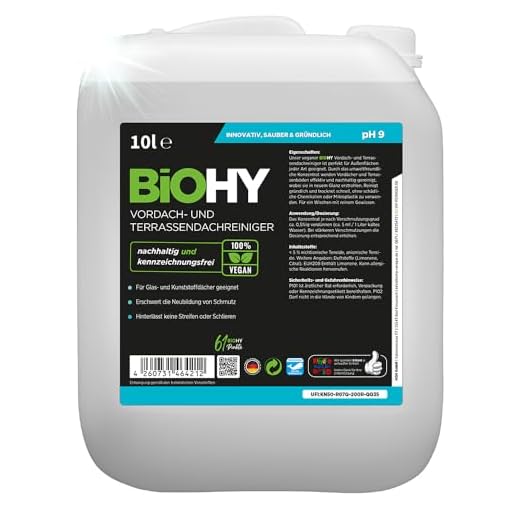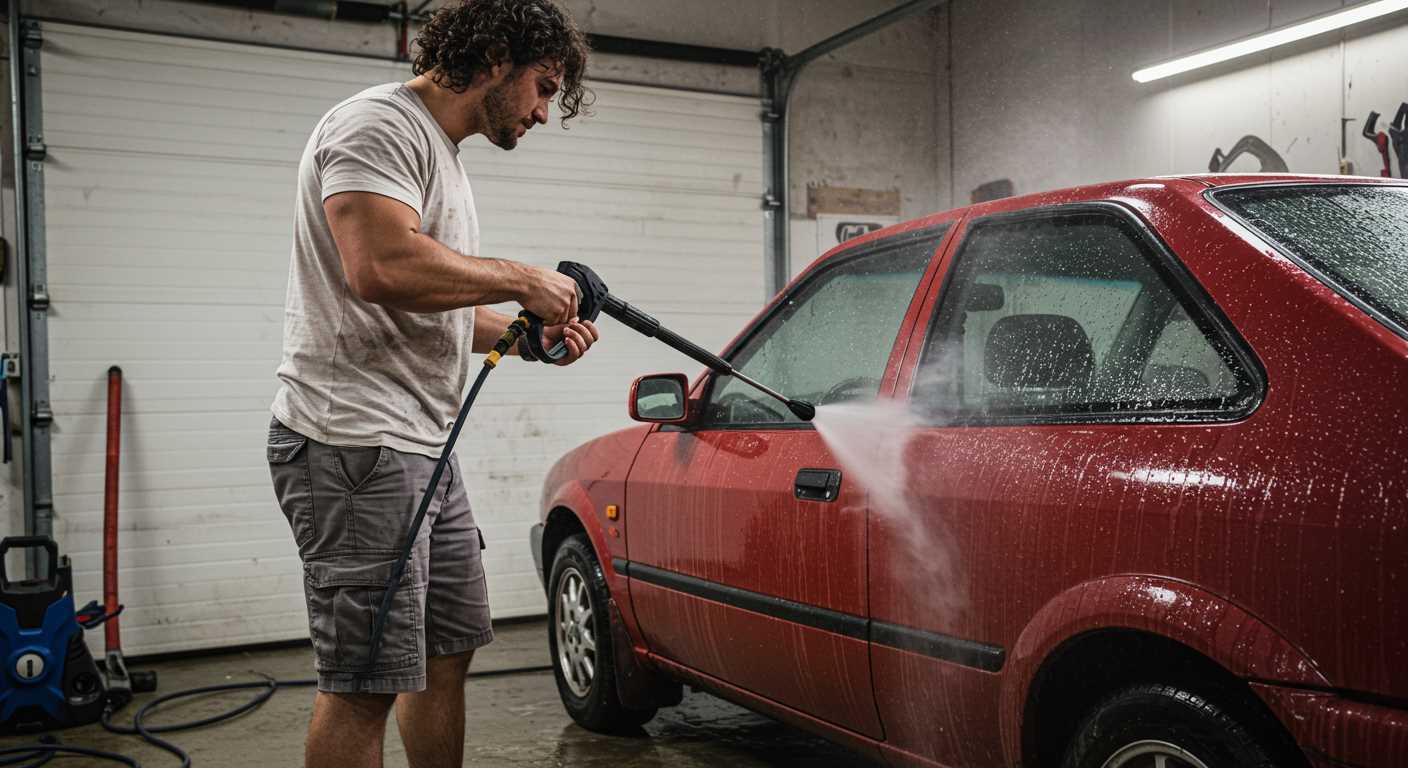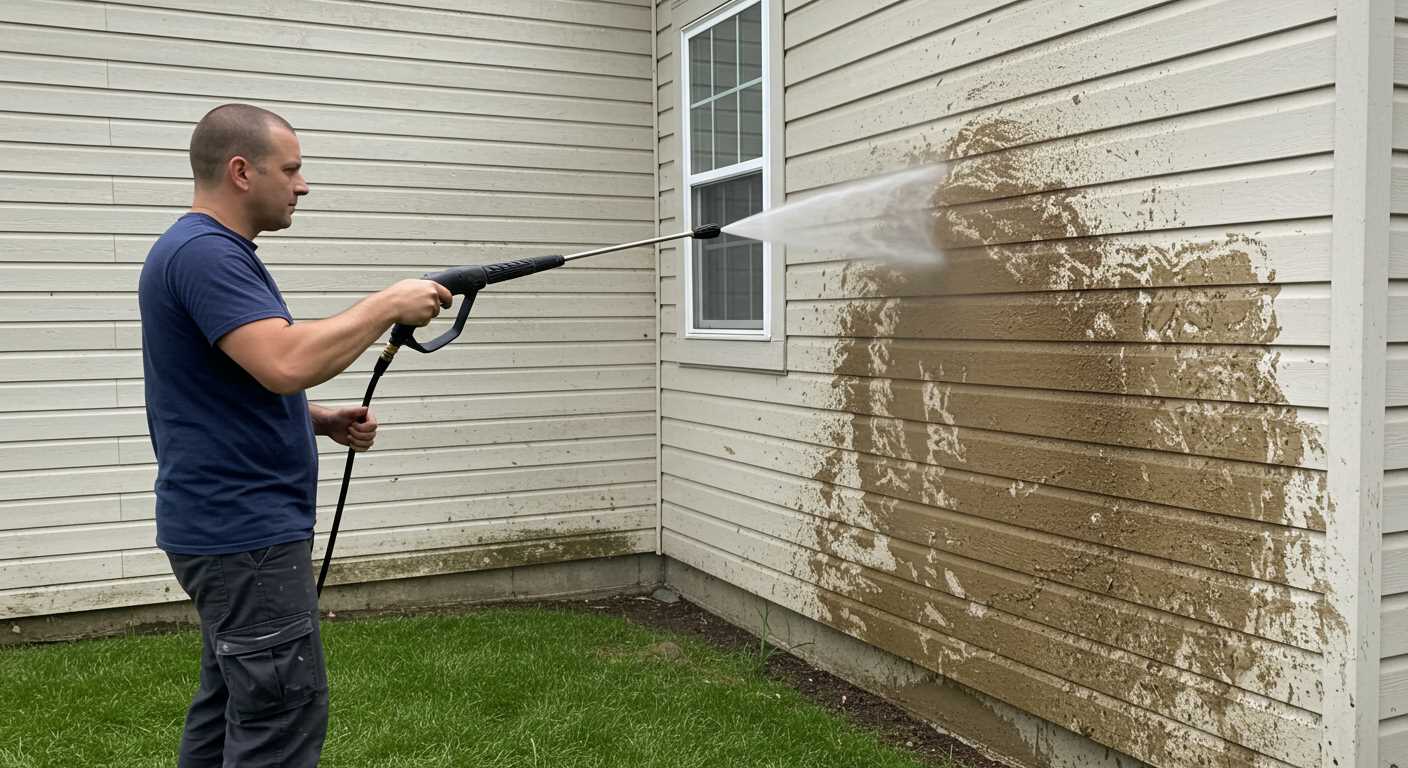



Yes, a high-pressure cleaner can effectively tackle stubborn grime, moss, and algae on your shingles or tiles. Utilizing the right technique and equipment can yield remarkable results, extending the life of your roof. Begin by selecting a model with adjustable pressure settings, ideally between 1300 to 2000 PSI, to avoid damaging delicate materials.
Before proceeding, ensure the area is clear of debris and valuables. Protecting surrounding plants with a tarp will safeguard them from any chemical runoff. It’s wise to apply a suitable cleaning solution specifically designed for roofing materials to break down stubborn stains and organic growth. After application, allow the solution to dwell for 10 to 15 minutes before rinsing off.
While washing, maintain a distance of approximately 12 to 18 inches from the surface to control the spray’s intensity. Working in sections prevents the cleaner from drying too quickly and ensures thorough rinsing. Once complete, observe the results and evaluate any areas needing additional attention. This method not only revitalises appearance but also supports the functionality of your roofing system.
Roof Cleaning Techniques
Using high-pressure equipment is feasible, but caution is paramount. Opt for a wide spray nozzle to reduce the intensity of the water stream. A narrower nozzle can cause damage to shingles or tiles, leading to leaks. Always maintain a minimum distance of 2-3 feet from the surface to avoid dislodging roofing materials.
Appropriate Cleaning Agents
Incorporating a suitable cleaning solution significantly enhances results. Look for biodegradable detergents specifically designed for outdoor surfaces. These products often contain surfactants that break down dirt and organic matter such as moss or algae, making the process smoother and more efficient.
Safety Measures
Safety cannot be overlooked. Use non-slip footwear and consider harnesses or safety ropes if the incline is steep. Ensure the equipment is rated for outdoor use and check the connections to prevent any accidents. Always work in dry conditions to minimise the risk of slips.
Understanding the Risks of Pressure Washing a Roof
Using a high-pressure device for cleaning rooftops poses several dangers that should be taken seriously. The potential for damage to both the structure and the individual remains significant.
Firstly, water intrusion is a major concern. High-pressure jets can penetrate under shingles, tiles, or even metal roofing, leading to leaks and water damage inside the building. This is especially true if there are any existing compromised areas.
Secondly, the risk of injury is considerable. Slips and falls are common incidents while performing such tasks. On steep or uneven surfaces, the chance of losing balance increases significantly. Proper gear, including non-slip footwear, is crucial.
Thirdly, the force generated by these machines can dislodge materials. Loose shingles or tiles may come off during the process. Even those in good condition might not withstand the intense pressure, leading to costly repairs or replacements.
The risk of injury extends to those who may be nearby. Debris can become projectiles and create hazards for individuals within the vicinity. It’s vital to ensure a safe working environment clear of bystanders.
Additionally, if the cleaning agent used is inappropriate for specific roofing materials, chemical reactions could compromise the integrity of the surface. Always check compatibility before application.
In summary, the associated risks of operating high-pressure cleaning equipment on rooftops demand careful thought and preparation. Assessing both the structure’s condition and personal safety measures is imperative before proceeding.
Choosing the Right Pressure Washer for Roof Cleaning

Opt for a model that delivers at least 2500 PSI for removing moss, algae, and dirt effectively. A higher PSI, such as 3000, is beneficial for tougher stains, but ensure it’s adjustable to prevent damage to shingles.
Below are key features to consider while selecting the ideal cleaning equipment:
- GPM Rating: Aim for a minimum of 2.0 GPM. This combination of pressure and flow rate enhances cleaning effectiveness by providing adequate water volume to flush away debris.
- Nozzle Selection: Choose a unit compatible with variable nozzles. A wider spray pattern (25° to 40°) is preferable for delicate surfaces to avoid chipping protective coatings.
- Heated Water Option: Models allowing for heated water can significantly aid in removing stubborn stains and biofilm.
- Adjustable Pressure: Ensure the machine allows adjustments based on surface type. This feature reduces the risk of potential damage.
Besides power specifications, consider the following:
- Mobility: Weigh the weight and wheel quality for easy manoeuvrability across uneven surfaces.
- Durability of Construction: Opt for robust materials proven to withstand outdoor conditions.
- Noise Level: A quieter model will maintain a peaceful environment while performing tasks.
Additionally, verify compatibility with eco-friendly cleaning solutions to enhance results while being gentle on the environment.
Finally, choose a reputable brand known for reliability and customer support. Investing in quality equipment can save time and reduce the risk of potential damages over the long term.
Identifying Roof Materials Suitable for Pressure Washing
Start by assessing the type of materials used on the structure. Asphalt shingles, known for their durability, can tolerate moderate water pressure effectively. Use a lower setting to prevent lifting or damaging the shingles. For clay tiles, it’s advisable to exercise caution; high-pressure settings can dislodge tiles and create cracks.
Metal roofs generally withstand pressure techniques well. They resist corrosion and can handle higher pressures. Ensure to use the correct nozzle to avoid scratching the surface. On the other hand, wooden shingles require gentle treatment. Strong pressure can strip away protective layers or lead to splintering, so using a fan spray at lower pressures is preferable.
Slate roofs also demand careful handling. Despite their sturdiness, they can be brittle. Stick to low pressure settings and avoid prolonged contact with any single area to prevent breakage. For synthetic roofing materials, the resilience varies; read the manufacturer’s recommendations before proceeding.
Finally, it’s essential to inspect for any existing damage before initiating this method. Repairing imperfections before cleaning will enhance the longevity of the finish and preserve the structure’s integrity.
Recommended Pressure Settings for Roof Cleaning

For effective maintenance of your rooftop surfaces, a pressure setting between 1200 to 1500 PSI is advisable. This range is gentle enough to prevent damage while being effective against dirt and grime.
Different materials require distinct approaches. For instance, asphalt shingles should ideally be washed at a lower setting, around 1200 PSI, to avoid dislodging granules. Conversely, concrete and metal roofs can tolerate higher pressures, making 1500 PSI suitable for these surfaces.
Here’s a concise breakdown for various materials:
| Roof Material | Recommended Pressure (PSI) |
|---|---|
| Asphalt Shingles | 1200 PSI |
| Metal | 1500 PSI |
| Concrete | 1500 PSI |
| Tile | 1300 PSI |
| Wood | 1000 – 1200 PSI |
Always maintain a distance of at least 2 feet from the surface, adjusting your technique to avoid creating holes or causing water intrusion. Following these guidelines ensures a thorough, yet safe, procedure for maintaining rooftop hygiene.
Safe Techniques for Operating a Pressure Washer on a Roof

Begin by selecting a suitable ladder to gain access to the upper areas securely. Ensure the base is stable and that the ladder extends at least three feet beyond the edge for safety.
Equip yourself with personal protective equipment: safety goggles, gloves, and a firm non-slip footwear. This reduces risk during operation.
Maintain a safe distance while directing the nozzle towards the surface. Start at the highest point, working downwards to promote effective drainage. Keep the spray angle at approximately 45 degrees to avoid forcing water under shingles.
Utilise a lower pressure setting initially to assess how the materials respond. If effective, gradually increase pressure as necessary. Avoid close-range spraying, as it could damage the surface.
Monitor surroundings continuously. Be cautious of power lines, trees, and uneven surfaces that may pose hazards while working. Engage a partner to assist, ensuring safety during equipment transport and operation.
Lastly, allow the area to dry adequately post-cleaning. This prevents the risk of slips and further water damage.
Cleaning Solutions to Use with a Pressure Washer
For optimal results, select a cleaning agent that complements the equipment’s capabilities while being safe for the surface treated. I recommend using a sodium hypochlorite mixture for algae and mildew removal. Dilute the solution to a ratio of one part sodium hypochlorite to three parts water. This concentration effectively targets organic growth without damaging materials.
Specific Detergents
Utilising a commercial-grade detergent designed for outdoor surfaces can enhance cleaning effectiveness. Look for ones with biodegradable formulas to ensure environmental safety. Products containing surfactants help in loosening dirt and grime, allowing for easier rinsing. Always check manufacturer guidelines for compatibility with your machine.
Application Techniques
When applying the solution, use a low-pressure setting to spray evenly across the area. Allow the detergent to sit for several minutes, but avoid letting it dry completely. Rinse thoroughly afterward with clean water, using the nozzle appropriate for your machine to prevent surface damage. Experiment with nozzle types to find the one that maximises cleaning efficiency while safeguarding the integrity of the surface.
Post-Cleaning Care for Your Roof
After completing the washing process, it is crucial to perform maintenance actions to ensure long-lasting results. Begin by inspecting all surfaces for any remaining dirt, stains, or damage that may need attention. If any stubborn marks are present, a soft-bristle brush and appropriate cleaning solution can aid in their removal.
Regular Inspections
Conducting routine assessments of the installed material can save significant costs over time. Look for signs of wear, such as cracked tiles or missing shingles. Address issues promptly to prevent further deterioration. Pay special attention to flashing and gutters, which may require periodic clearing of debris to enhance water flow and prevent blockages.
Preventive Measures

Once the surfaces are clean, consider applying a protective treatment designed for the specific material. Such coatings can guard against moss, algae, and weather damage. Additionally, install moss and algae inhibitors combined with regular gutter cleaning to maintain cleanliness and avoid build-up. Maintaining a clear perimeter around the structure by trimming overhanging branches can also help in minimising future debris accumulation.
Lastly, develop a seasonal maintenance schedule to keep surfaces looking pristine. Scheduling cleanings twice a year, preferably in spring and autumn, can keep dirt and biological growth at bay. Staying vigilant and proactive will extend the lifespan of the material and ensure your home remains visually appealing and structurally sound.
When to Hire a Professional for Roof Cleaning

Engage a specialist if any of the following conditions arise. If your rooftop showcases significant algae, moss, or lichen growth, the expertise and equipment of a professional can ensure thorough removal without risking damage. Complex slopes or challenging heights warrant skilled hands, as safety should always come first.
Consider enlisting help if your materials are vulnerable, such as delicate asphalt shingles or older structures that require mindful attention. An expert understands the nuances of various surfaces and will employ the appropriate techniques and tools to avoid compromising integrity.
If you’re unsure about the effectiveness or suitability of specific cleaning solutions, a qualified service can recommend or apply formulations designed to enhance safety and outcomes. Additionally, if you possess a lack of experience in handling advanced equipment or if time constraints prevent you from undertaking this task, relying on trained professionals can relieve stress and ensure a high-quality finish.
Lastly, if you’ve experienced prior damage or repairs, it’s wiser to consult an expert who can assess the current condition and suggest the best approach for maintenance, ensuring longevity and performance of your structure.
FAQ:
Is it safe to use a pressure washer on my roof?
Using a pressure washer on your roof can be safe, but there are important factors to consider. First, ensure that your roof material is suitable for pressure washing. Tile and metal roofs usually withstand the pressure well, whereas shingles can be damaged. It’s also crucial to use the correct pressure setting; a high-pressure jet can dislodge shingles or create leaks. Additionally, safety precautions should be observed, such as using a sturdy ladder and considering the angle of the roof to prevent falls.
What are the benefits of cleaning a roof with a pressure washer?
Cleaning a roof with a pressure washer has several benefits. It effectively removes dirt, mildew, algae, and moss, which can harm your roof over time. A clean roof not only enhances the appearance of your home but can also extend the life of roofing materials by preventing decay. Furthermore, regular cleaning improves energy efficiency, as a clean roof reflects sunlight better, keeping your home cooler during hot weather. However, it is advisable to combine pressure washing with appropriate cleaning solutions for optimal results.
How can I prepare my roof for pressure washing?
Preparing your roof for pressure washing involves several steps. First, remove any debris, such as leaves or branches, from the surface. This helps the pressure washer reach all areas more effectively. Next, check for loose or damaged shingles and repair them before washing. It’s wise to cover or protect plants and shrubs near the house, as the pressure wash can displace dirt and water. Finally, if using a cleaning solution, make sure to test it on a small, inconspicuous area of the roof to ensure it won’t cause damage or discoloration.









